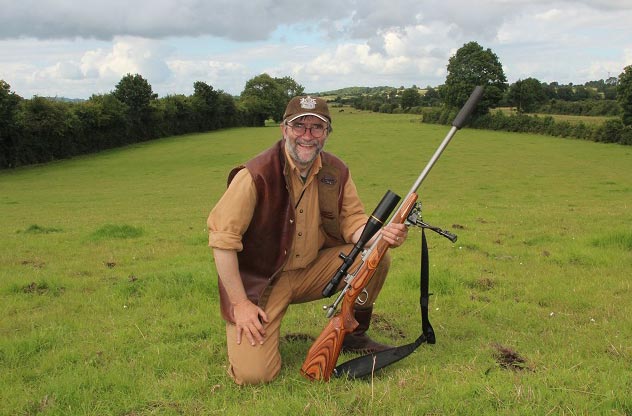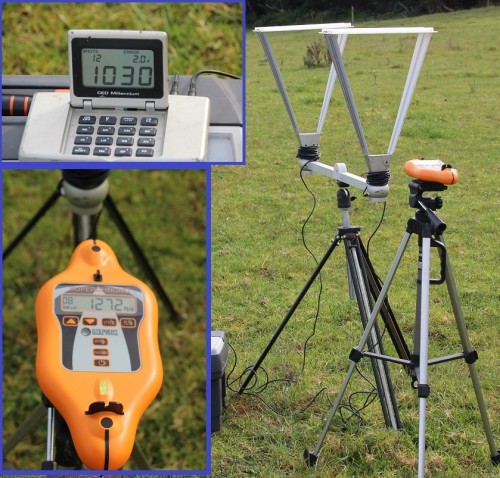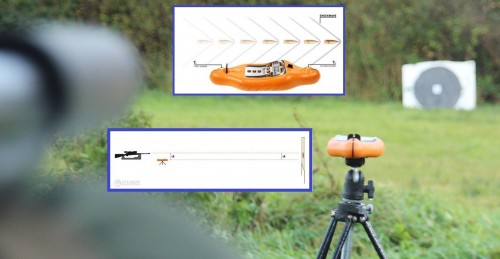«It performed flawlessly and took several readings in late evening light that defeated the laser based CED chronograph. «

Chronographs – they drive us demented by times but you can achieve nothing without them. They are fragile, awkward, temperamental, have multiple components one of which is always somehow missing and they refuse to work if the light is not perfect. They take time to set up and aligning the sensors, antennae and rifle is a job that would try the patience of a saint. Once aligned the antennae catch the wind and the entire edifice is liable to twist, sag and fall. A misplaced bullet will rip away an antenna and a really misplaced shot will cost you a couple of hundred for a new chronograph. I am, of course referring to chronographs that use two light sensors to calculate the time it takes for a bullet to travel between them. I have owned two in the last thirteen years and both have been struck by bullets which did nothing for their functionality. The problem is light. The closer the bullet is to the sensors the better chance there is the sensors will “see” it. Unfortunately one sometimes forgets there is a 1-2 inch disparity between the line of sight and the bullet path with the unfortunate result that the bullet sometimes strikes the chronograph. Very few people will risk getting velocity readings beyond ten feet because it is so difficult to keep the bullets close to the sensors while avoiding breakages.
I was recently asked by Niall and Tom at Lakeland Shooting Centre to try out the new Steinert “Superchrono” which is a sonic chronograph. It detects not light but the shockwave of the bullet and uses that to calculate speed. I had it all to myself at An Riocht for two days and used it to develop loads for my .45-90 Sharps and .45 Colt carbine. The Steinert “Superchrono” is a bright orange colour and I can’t understand why no-one thought of a high visibility chronograph before. It appears even in a telescopic sight as a bright orange slightly out of focus blur. It is un-missable or very missable depending on how one interprets the term. I set up two chronographs in train and fired over both simultaneously – the Steinert “Superchrono” and my own CED Millennium which I’ve used for many years. I placed the Steinert “Superchrono” well below the line of the CED Millennium to avoid the possibility of a mishap and proceeded to gather velocity data. I immediately ran into a problem as the readings from the Steinert “Superchrono” were massively higher than those from the CED Millennium. I moved everything from 8 out to 13 feet and tried again. This time readings were closer and I settled down to do some serious chronographing.
Both units worked perfectly as expected – the CED Millennium usually gives trouble only in very poor light or light from a low angle at evening. I discovered that the read zone of the Steinert “Superchrono” was larger and easier to hit and it managed to read speeds even when the shot was quite high as when I fired some supersonic pistol loads. The only difficulty arose with subsonic loads in rifle and pistol which it could not detect. This is because subsonic loads do not generate a shockwave in the same way supersonic loads do. The Steinert “Superchrono” is therefore capable of detecting speeds of 1126 feet per second and greater. The difference between speeds reported by the CED Millennium and the Steinert “Superchrono” were in the region of 1.03% to 1.75%. I intend to run these tests again under different conditions with both units at a distance from the muzzle of more than 12 feet. In other regards the Steinert “Superchrono” was far more user friendly than other chronographs. It has no antennae and can be sited comfortably below the line of fire and therefore requires far less setting up time. It is compact, has rounded edges and is extremely robust. It has a large flat base unlike some chronographs and sits comfortably on any reasonably flat surface or attaches to a camera tripod. It requires nothing more elaborate than a small general purpose bag (I used a discarded ladies’ handbag) to protect it from knocks when out of use. It has no wires, is simple to use and utterly reliable in all light conditions. On the down side, the price is quite high compared to some models that use light sensors. It records only velocities above the speed of sound – it won’t do subsonic bullets. It is sensitive to muzzle blast and has to be positioned more than 12 feet from the muzzle. It returns velocities about 1.3% higher than my light sensor model but it is not possible to say which is more correct since calibration using scientific equipment was not
possible. It will not connect to a computer but this really doesn’t matter since few people bother anyway. The instructions are a bit complex and I’ll need more time to get familiar with correct operation. I PREFER it to my light sensor chronograph because it is handy, reliable and rugged. I can’t use for developing pistol loads. it’s for high-velocity rifles only.
The Steinert Sonic Chronograph One Month On
The Steinert SuperChrono
Caption: Rifle-type back and front sights align the Superchrono with the target while the shooter aims over it but at the same angle for a precise velocity reading
Last month we tried out the Steinert Sonic Chronograph. At that time I noticed a slight difference between readings taken with it and those obtained with my own CED laser-based chronograph so I contacted Halvdan S. Nicolaysen, managing Director at Steinert who provided me with detailed instructions on how to set up and use the “Superchrono”. The explanation he provided was simple and logical – the bullet path must be parallel to the axis of the chronograph for optimum precision and the Superchrono is provided with sights to help the shooter align it properly. Angled shots are likely to be read less accurately. With this in mind I used the Steinert to develop a supersonic load for my Mauser .45 Colt carbine and found it to be very practical indeed. Because the technology is based on the shockwave of a supersonic bullet, velocities can be read after dark, on dull days and even indoors. It performed flawlessly and took several readings in late evening light that defeated the laser based CED chronograph. It is so user-friendly I have almost stopped using the CED except for developing subsonic loads which do not register on sonic technology due to the absence of a detectable shockwave. Another unthought-of advantage to sonic technology is the absence of the “sunshades” which stick up from laser chronographs and are constantly getting shot to pieces. It is now possible to position a sonic chronograph behind a barrier and take readings at long range without the risk of wind drifting the bullet into the fragile sunshades. The setting up time is also cut to seconds thanks to the absence of wires or sunshades and the unit stores in a small box or bag whereas previously toolbox-sized storage was required. The bright orange colour is another nice feature and can be seen clearly even at short range in powerful and out-of-focus target scopes.
This is the best piece of chronographing equipment I have seen since the first affordable models appeared on the market over thirteen years ago. A Christmas present for the shooter who has everything else?

The Steinert SuperChrono

